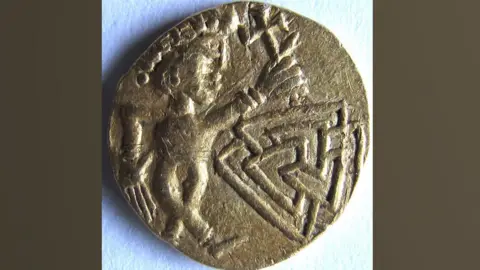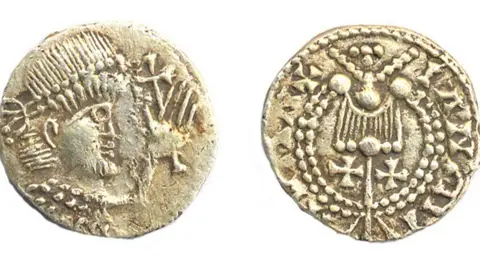One of a kind 7th Century gold coin found in field
 Adrian Marsden
Adrian MarsdenA tiny gold coin that is believed to be the oldest from the Anglo-Saxons in East Anglia has been found in a field.
Coin expert Adrian Marsden described the coin as a "massively significant" find that was struck in the 7th Century.
The design depicts a man dancing a jig while holding a Christian cross above a symbol linked to the Norse god Odin.
The coin was discovered by a metal detectorist near Norwich in the autumn and Norwich Castle Museum hopes to acquire it.
 Adrian Marsden
Adrian Marsden"It's the first one of this type of coin that we've seen and new types of shillings just don't turn up," said Dr Marsden, from the Norfolk Historic Environment Service.
"It's got this fascinating iconography of a little figure with a long cross - explicitly Christian - over the valknut design, which has pagan roots."
Dr Marsden said all the evidence pointed to it being "the earliest Anglo-Saxon East Anglian coin so far known", dating it to AD640 to 660.
It was struck at a time when pagan beliefs were starting to give way to Christianity, and its design appears to straddle this time of change.
Experts associate the design with the god Odin, whose roles in Norse mythology included ferrying the dead to the afterlife.
In the 20th Century, the valknut was adopted as a symbol by white supremacists among others.
The coin dates back to the same era as the famous Sutton Hoo ship burial, which, as Dr Marsden explained, had a mix of Christian and pagan grave goods.
 Getty Images
Getty ImagesOn the reverse of the coin is a design that could be a cross or could be a swastika, then recognised as a good luck symbol, surrounded by an attempt at a Latin inscription.
Dr Marsden recently published his research in the Searcher.
"It's plain from looking at the letters that whoever made the die wasn't literate, the letters don't bear much resemblance to Latin - they're garbage really," he explained.
Testing revealed the coin was made from a very high gold content, of up to 60%.
 Adrian Marsden
Adrian MarsdenDr Marsden also pointed out it was the second coin in Norfolk to benefit from a new treasure definition on "the basis of national significance".
The government changed the legal definition of the 1996 Treasure Act two years ago, to try getting more artefacts on public display.
A coroner decides if a discovery is treasure and a museum usually gets first refusal over whether to store it.
Follow Norfolk news on BBC Sounds, Facebook, Instagram and X.
